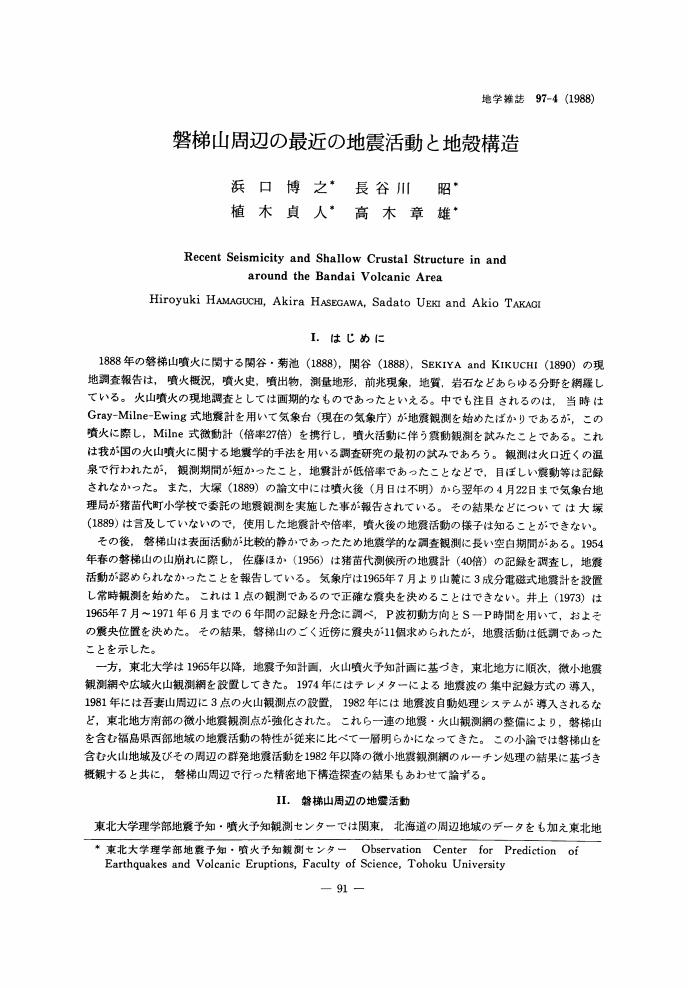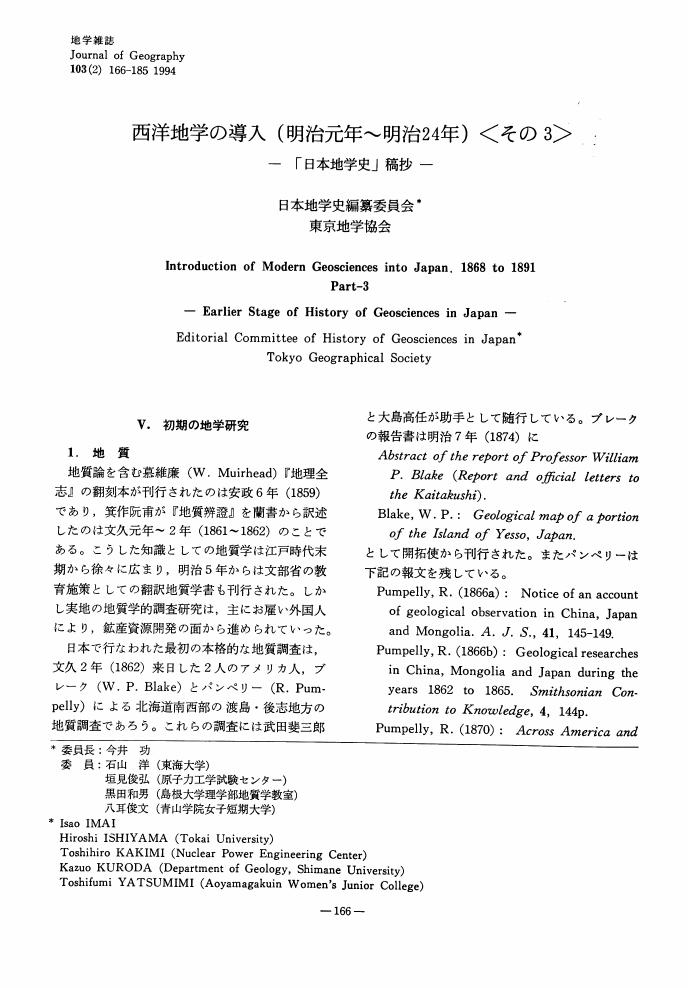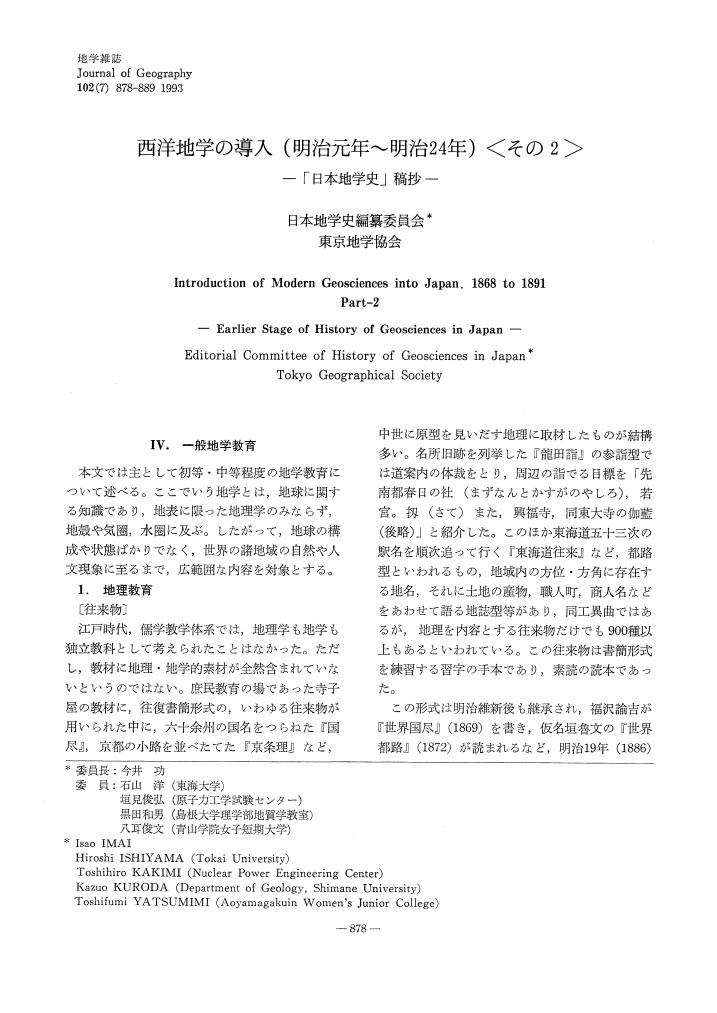- 著者
- 石橋 克彦
- 出版者
- Tokyo Geographical Society
- 雑誌
- 地學雜誌 (ISSN:0022135X)
- 巻号頁・発行日
- vol.108, no.4, pp.399-423, 1999-08-25
- 被引用文献数
- 4 18
A large volume of historical documents in Japan show that great subduction earthquakes have repeatedly occurred along the Suruga-Nankai trough off southwest Japan since A.D. 684 with an interval of 100-200 years. They occurred as pairs of <I>M</I>8 events, one in the eastern half (Tokai earthquake) and another in the western half (Nankai earthquake), as was the case for the 1854 Ansei earthquakes, while sometimes occurring as single giant events like the 1707 Ho'ei earthquake. Although the space-time pattern of their recurrence is the best-known in the world, we should study more past events in order to understand the tectonophysical bases of their recurrence. In this respect I review the present understanding of historic Tokai and Nankai earthquakes and discuss related problems from the viewpoint of historical seismology. In this paper, the first of the three in all, I review the events until the early half of the 14th century. The keys to identifying older events are strong ground motion and damage in Kyoto, Nara, and Osaka, those in wider area of southwest Japan, tsunamis along the Pacific coasts of southwest Japan, typical coseismic vertical crustal movements of the Kochi plain, the Muroto and Oma'ezaki points, and the Ise and Suruga Bay coasts, temporal inactivity of specific hot springs, and aftershock activities recorded in Kyoto. The 684 Hakuho earthquake was definitely a Nankai event, and possibly included a Tokai event simultaneously (possibly Ho'ei type). The 887 Nin'na earthquake was also a definite Nankai event and was probably a Tokai event as well (Ho'ei type). The 1096 Eicho earthquake was clearly a Tokai event, but the following 1099 Kowa earthquake has some discrepancies that prevent it from being regarded as a <I>M</I>8 Nankai event. It is not clear yet whether great earthquakes occurred or not in the ca. 200 year intervals of 684-887 and 887-1096. It seems probable that great Tokai and Nankai earthquakes took place in the mid-13th century, but a more detailed investigation of historical seismology is required to discover the missing event.
- 著者
- Radvanec Martin
- 出版者
- Tokyo Geographical Society
- 雑誌
- 地學雜誌 (ISSN:0022135X)
- 巻号頁・発行日
- vol.118, no.4, pp.686-699, 2009-08-25
- 参考文献数
- 30
- 被引用文献数
- 2
この研究は,1945年8月6日,午前8時15分,広島の原子爆弾爆発による熱線の強力な影響を,2片の被爆瓦片を用いて研究したもので,この瓦片は元安川に架かる元安橋下流約100mの西岸で1977~1982年にかけて発掘されたものである。爆発から1.318秒後,爆心地で破壊された建物から衝撃波によって吹き飛ばされた大変熱くて融解した多数の破片は,元安川西岸に堆積した。この瓦片はおそらく,破壊された清病院の石塀,西向寺および(もしくは)西蓮寺からのもので,川の水で急激に冷却されたものと思われる。<br> 瓦片は安山岩質の火山砕屑岩からなり,その表面は3.18mmの深さまで融解していた。そのガラス質の層は,安山岩から玄武岩質安山岩の組成をもつ。これらはクリストバル石および/もしくはリンケイ石,ピジョン輝石(X<sub>Fe</sub> = Fe/(Fe + Mg)= 0.37-0.44),角閃石(X<sub>Fe</sub> = 0.33-0.42),曹灰長石(Ab<sub>48.2-40.6</sub>An<sub>51.8-55.5</sub>Or<sub>0-3.9</sub>)およびK-長石(Ab<sub>8.2</sub>Or<sub>91.8</sub>)が融解生成したものである。融解が3.18mmの深さにまでおよんでいることと,上記鉱物質のそれぞれ異なる融点および溶融深度から,爆発後の爆心地の物体表面の温度6287℃が算出された。この表面温度は,深さ2.68~3.18mmの区間における残存鉱物と,溶融深度の関係から導き出した。回帰直線<i>T</i> = -1715.1<i>d</i> + 6287(<i>d</i>は深さ)(<i>R<sup>2</sup></i> = 0.989)を外挿して求めたものである。安山岩瓦表層部の温度勾配は1mmあたり1715℃で,深さが2.86mmから3.18mmの間では,融解ガラス質と本来の鉱物質は等量である。3.64mm以下では,火山砕屑安山岩の構造および鉱物組成は,本来の組成を有している。
2 0 0 0 サハリンの活断層の分布と概要
- 著者
- 鈴木 康弘 堤 浩之 渡辺 満久 植木 岳雪 奥村 晃史 後藤 秀昭 STREL'TSOV Mihail I. KOZHURIN Andrei I. BULGAKOV Rustam TERENTIEF Nikolai IVASHCHENKO Alexei I.
- 出版者
- Tokyo Geographical Society
- 雑誌
- 地學雜誌 (ISSN:0022135X)
- 巻号頁・発行日
- vol.109, no.2, pp.311-317, 2000-04-25
- 被引用文献数
- 1 4
We have prepared a preliminary active fault map of Sakhalin, Russia, based on an interpretation of aerial photographs and satellite images. Major active structures include 110-km-long active faults along the western margin of the Yuzhno-Sakhalinsk Lowland in southern Sakhalin and 120-km-long active faults along the western margin of the Poronaysk Lowland in central Sakhalin. These active faults are parallel to but are located as far as 10 km east of the Tym-Poronaysk fault. Geomorphic surfaces on the upthrown side of the fault are tilting westward, therefore, the faults are considered to be west-dipping low-angle reverse faults. The vertical component of slip rates of these faults are >0.3 mm/yr in southern Sakhalin and 1.0-1.5 mm/yr in central Sakhalin. The net-slip rates could be much greater because the faults are low-angle reverse faults. If these faults rupture along their entire length during individual earthquakes, the earthquakes could be as great as M7.6-7.7. In northern Sakhalin, we have identified a series of right-lateral strike-slip faults, including the 1995 Neftegorsk earthquake fault. The slip rates for these faults are estimated at 4 mm/yr. The right-lateral shear in northern Sakhalin and east-west compression in central and southern Sakhalin may reflect relative plate motion in far-east Asian region.
2 0 0 0 OA 磐梯山周辺の最近の地震活動と地殻構造
- 著者
- 浜口 博之 長谷川 昭 植木 貞人 高木 章雄
- 出版者
- Tokyo Geographical Society
- 雑誌
- 地学雑誌 (ISSN:0022135X)
- 巻号頁・発行日
- vol.97, no.4, pp.333-340, 1988-08-25 (Released:2011-02-17)
- 参考文献数
- 15
2 0 0 0 隠岐國竹島に關する地理學上の智識
- 著者
- 田中 阿歌麻呂
- 出版者
- Tokyo Geographical Society
- 雑誌
- 地学雑誌 (ISSN:0022135X)
- 巻号頁・発行日
- vol.18, no.6, pp.415-419, 1906
2 0 0 0 本月十五日十六日の日蝕皆既
- 著者
- 大川 通久
- 出版者
- Tokyo Geographical Society
- 雑誌
- 地学雑誌 (ISSN:0022135X)
- 巻号頁・発行日
- vol.5, no.4, pp.194-196, 1893
2 0 0 0 韓國戸口數 (光武六年)
- 出版者
- Tokyo Geographical Society
- 雑誌
- 地学雑誌 (ISSN:0022135X)
- 巻号頁・発行日
- vol.15, no.3, pp.273a-274, 1903
2 0 0 0 韓國の改元及前帝の稱號
- 出版者
- Tokyo Geographical Society
- 雑誌
- 地学雑誌 (ISSN:0022135X)
- 巻号頁・発行日
- vol.19, no.10, pp.759a-759a, 1907
2 0 0 0 地質学り講義第二回 (圖入)
- 著者
- 鈴木 敏
- 出版者
- Tokyo Geographical Society
- 雑誌
- 地学雑誌 (ISSN:0022135X)
- 巻号頁・発行日
- vol.1, no.7, pp.307-317, 1889
2 0 0 0 會津城下い往昔湖底たり
- 出版者
- Tokyo Geographical Society
- 雑誌
- 地学雑誌 (ISSN:0022135X)
- 巻号頁・発行日
- vol.1, no.9, pp.440-440, 1889
1 0 0 0 OA 新潟県粟島の海成段丘からみた地震隆起の累積に関する検討
- 著者
- 太田 陽子 柏木 修一 桜井 一賀 池田 潤
- 出版者
- Tokyo Geographical Society
- 雑誌
- 地学雑誌 (ISSN:0022135X)
- 巻号頁・発行日
- vol.97, no.1, pp.25-38, 1988-02-25 (Released:2009-11-12)
- 参考文献数
- 17
- 被引用文献数
- 3 2
Awashima is a small (7 × 2 km) island on the continental shelf along the wetsern coast of northern Honshu, and uplifted with northwestward tilt associated with the 1964 Niigata earthquake (Figs. 1 and 5). NAKAMURA et al. (1964) proposed a cumulative character of the coseismic uplift since the middle Miocene, of the island, based on the comparison of terrace profile and geologic structure of Tertiary sedimentary rocks with the coseismic tilt by the Niigata earthquake. This paper intends to establish such a progressive tilt of the island, on the basis of the detailed investigation of marine terraces.Marine terraces of Awashima are divided into H, M1, M2 and L terraces (Fig. 2). They are abrasion platforms and no tephra and terrace deposits are found, except thick deposits of L terrace at Uchiura area. The most extensive terrace, M1, can be regarded to be formed at the time of the last interglacial maximum (ca. 125 ka). The height of the former shoreline of M1 terrace ranges from ca. 75 in to the northeast to ca. 50 m to the southwest, indicating a notable northwestward tilt, which is similar to that of the 1964 earthquake, but having much steeper gradient. The gradient of the northwestward tilt of M1 terrace (20 × 10-3) is about 67 times of that of the coseismic tilt at the time of 1964 earthquake (0.3 × 10-3). It suggests that the similar coseismic uplift has repeated since the last interglacial maximum with interval of about 1900 years. Estimated resultant coseismic uplift is about 1.1 m at the northeastern part of the island, where M1 terrace is 75 m high, which is approximately same to the height estimated by the amount of coseismic resultant uplift of 67 times. Thus, average recurrence interval of the major earthquake resulting in the coseismic uplift of Awashima is estimated to be about 1900 years from the comparison of amount of both tilt and uplift.However, no significant difference is observed in terrace profiles of Ml, between A-B, parallel to strike of the tilt, and C?D or E?F, normal to it (Fig. 4). Therefore, terrace profile seems to be an unsuitable indicator for the detection of tectonic deformation, unless much steeper tilt has occured. Distribution of H and M2 terraces is too limited to discuss the deformation pattern.L terrace at Uchiura is underlain by thick marine deposits attaining ca 60 m thick, suggesting that it was formed in association with the postglacial sea level rise. No datable material was found despite examination of many borehole data and our excavation works. L terrace is subdivided into L1, L2 and L3 terraces. Episodic or intermittent emergence, probably coseismic, should have occurred at least 3 times since ca. 6000 yBP. It is consistent with the result obtained by Mi terrace. The height of L1 terrace is ca. 11 m above mean sea level, which means average uplift rate is ca. 1.5 m/ka, it is much larger than 0.7 m/ka for Mi terrace. Northwestward tilt of the lower terraces, however, is not confirmed by this study, owing to the limited distribution.
1 0 0 0 OA 全生物の共通の祖先の実験的検証
- 著者
- 山岸 明彦
- 出版者
- Tokyo Geographical Society
- 雑誌
- 地学雑誌 (ISSN:0022135X)
- 巻号頁・発行日
- vol.112, no.2, pp.197-207, 2003-04-25 (Released:2009-11-12)
- 参考文献数
- 24
- 被引用文献数
- 1
The results of an experimental test for verifying the hypothesis that the common ancestor of all living organisms (universal ancestor, commonote) was a hyperthermophile (Miyazaki, et al., 2001), are explained. In the experiment, mutant enzymes with ancestral aminoacids were made using a gene engineering technique. The mutant enzymes were purified and tested for thermostability. The mutant enzymes with ancestral aminoacids showed higher thermostability than the contemporary hyperthermophile enzyme. The results suggest that the common ancestor of all living organisms was a hyperthermophile. The argument related to the hyperthermophilic common ancestor hypothesis was reviewed with respect to the experimental test.
1 0 0 0 OA 18世紀の日本における冬の気候復元
- 著者
- 深石 一夫 田上 善夫
- 出版者
- Tokyo Geographical Society
- 雑誌
- 地学雑誌 (ISSN:0022135X)
- 巻号頁・発行日
- vol.102, no.2, pp.176-182, 1993-04-25 (Released:2010-11-18)
- 参考文献数
- 19
In order to reconstruct the winter climate in Japan in the 18th century, the authors tried to gather weather records of old diaries written in that period. The winter climate in Japan is influenced by the east high-west low pressure pattern and its severity is highly correlated with the frequency of the pressure pattern on a seasonally or monthly time scale. The weather distribution pattern under the west high-east low pressure type is characterized by the bad weather in Japan Sea Coast and fine one in Pacific Coast.By the use of the character of the weather distribution pattern under the winter pressure, the frequencies of the typical winter days are interpreted from the weather distribution diagram made for the research period on a daily base from 1st November of the former year to the 31 st March of the year. The stations of the diaries gathered for the study are Hirosaki, Takada, Kanazawa, Sabae, Tottori and Hagi as Japan Sea Coast, Hachinohe, Morioka, Nikko, Kofu, Ise, Kyoto, Ikeda, Tsuyama and Usuki as inland or Pacific Coast.The results obtained from the study are shown in Figure 1 as an annual number of the frequency of winter pressure days. On the same time scale, the freezing dates and the records of unusual weather in winter (cold or mild) are composed in the figure. The relationsbetween the frequency and other historical documents are investigated.The secular changes of severity in winter were well coincided with the other weather proxies. The cold winter years can be found in the decades in the 1700s-1710s, the former 1730s, the 1750s and the former 1780s. The warmer winter years were in the decades in the 1720s, the 1740s, the 1770s, and the 1790s. Unusual severe winters recorded in the periods are not always identical to the frequency of the winter pressure days, because of its temporal or local effects.
1 0 0 0 OA 1999集集地震による地震断層の位置と既存の活断層との関係
- 著者
- 太田 陽子 渡辺 満久 鈴木 康弘 澤 祥
- 出版者
- Tokyo Geographical Society
- 雑誌
- 地学雑誌 (ISSN:0022135X)
- 巻号頁・発行日
- vol.112, no.1, pp.18-34, 2003-02-25 (Released:2009-11-12)
- 参考文献数
- 24
- 被引用文献数
- 2 2
A remarkable surface rupture appeared in the 1999 Chichi earthquake, in central Taiwan. The nature and location of the earthquake fault was studied in detail immediately after the earthquake (e.g., Central Geological Survey, Taiwan, 2000). Its location to the pre-existing active fault trace, however, was unknown. We wish to establish a location relationship between the earthquake fault and the pre-existing active faults which are mapped from photo interpretation at a scale of 1 : 20, 000, taken in 1970's, supplemented by field observation. The identified active faults are divided into four types from I to IV, depending on their certainty as active faults as well as their location accuracy. A Type I fault is where the active fault is definite and location is certain, II is also an active fault, but with a little uncertainty as to exact location due to subsequent erosion of the fault sacrp, and also because of sedimentation on the foot-wall, and III is a concealed fault beneath the younger sediment. Type IV appeared as a lineament without any clear evidence of deformed morphology. After mapping these active faults, we added the location of our observation to the 1999 surface rupture and GPS sites for measuring the earthquake fault using CGS map (2000).We present eight areas to show the exact relationship between active fault trace and earthquake fault trace and summarized them into Fig. 10. We concluded that most (ca. more than 80%) of the earthquake fault trace occurred exactly on the active fault of Type I and II. The earthqauke fault often appeard even on lineament of Type IV, implying that this lineament should be mapped for the acive fault map. On the young alluvial lowland where it is too young to record past faulting, the earthquake fault still appears on the probable extension of known active fault trace. The earthquake fault sometimes jumps from one fault to another where two or three active fault traces are recognized. Although we can not explain the reason for such a jumping, the earthquake fault still appears on one of the known faults. Therefore, repeated faulting activity during the late Quaternary on the same trace was confirmed for the Chelugmu Fault. This implies the detailed mapping of many other active faults in Taiwan, including Type III and IV, is essential for the understanding of future rupture locations.
1 0 0 0 OA バリの風土についての序論
- 著者
- 榧根 勇
- 出版者
- Tokyo Geographical Society
- 雑誌
- 地学雑誌 (ISSN:0022135X)
- 巻号頁・発行日
- vol.102, no.7, pp.793-805, 1993-12-25 (Released:2009-11-12)
- 参考文献数
- 33
A Fuudo of Bali, Indonesia is discussed through aspects of water and agriculture in Bali. The concept of Fuudo used here, which may be translated into Western words as clima, oikos, or milieu, is the same as that defined by Teturo Watsuji or Tokuji Chiba. Discussed in details are the difference in Hindu gods between India and Bali, the concept of direction in Bali, and the triad principle in Bali. Importance of the triad principle which is fundamentally different from the dualism in the Western world is stressed.
1 0 0 0 OA 第四紀後期における日本列島周辺の海水準変動
- 著者
- 大嶋 和雄
- 出版者
- Tokyo Geographical Society
- 雑誌
- 地学雑誌 (ISSN:0022135X)
- 巻号頁・発行日
- vol.100, no.6, pp.967-975, 1991-12-05 (Released:2009-11-12)
- 参考文献数
- 12
- 被引用文献数
- 36 37
1 0 0 0 OA キンバレー岩産地の地質学的特徴と同岩の本源に関する考察
- 著者
- 柴田 勇
- 出版者
- Tokyo Geographical Society
- 雑誌
- 地学雑誌 (ISSN:0022135X)
- 巻号頁・発行日
- vol.72, no.3, pp.131-138, 1963-06-30 (Released:2009-11-12)
- 参考文献数
- 28
Common geological features of the known kimberlite-occurring regions in the continents are briefly described with special notice to certain tectonic processes that seem to be linked to the eruption of kimberlites.Some investigators suppose that kimberlite magma originated in the peridotite layer just below the Mohorovicic discontinuity. Judging, however, from the tectonic processes prior to the eruption of kimberlites in most regions and the structural model concerning to the crust and the upper mantle supported by the writer, sources of kimberlites might be in more deeper part of the mantle than the peridotite layer.
1 0 0 0 OA カムチャツカ半島の近年の氷河質量収支変動と気候変動復元
- 著者
- 白岩 孝行 山口 悟
- 出版者
- Tokyo Geographical Society
- 雑誌
- 地学雑誌 (ISSN:0022135X)
- 巻号頁・発行日
- vol.111, no.4, pp.476-485, 2002-08-25 (Released:2009-11-12)
- 参考文献数
- 28
- 被引用文献数
- 13 12
More than 400 glaciers exist in the mountains of Kamchatka Peninsula and they constitute the southern boundary of present-day glacierization along the eastern coast of the Eurasian continent. The mass balances of the glaciers are characterized by decadal and interdecadal oscillations, and they are closely related to those observed in the glaciers of Pacific North America. A negative relation was also found for the net accumulation timeseries reconstructed by ice cores from Ushkovsky Volcano, Kamchatka, and Mt. Logan, Canada, for the last 170 years. Because the oscillations of the net accumulation rate and the average annual δ 18O reconstructed from Ushkovsky-ice-core seem to be closely correlated with the so-called Pacific Decadal Oscillation (PDO) Index, it was suggested that the mass balances of the glaciers at both sides of the North Pacific had been affected not only by global warming trends but also by the interdecadal climate variability that had dominantly been occurring over the North Pacific.
1 0 0 0 OA 西洋地学の導入 (明治元年-明治24年)〈その3〉
- 著者
- 日本地学史編纂委員会 (東京地学協会)
- 出版者
- Tokyo Geographical Society
- 雑誌
- 地学雑誌 (ISSN:0022135X)
- 巻号頁・発行日
- vol.103, no.2, pp.166-185, 1994-04-25 (Released:2010-12-22)
- 参考文献数
- 109
- 被引用文献数
- 1 1
1 0 0 0 OA 西洋地学の導入 (明治元年~明治24年) 〈その2〉
- 著者
- 日本地学史編纂委員会 東京地学協会
- 出版者
- Tokyo Geographical Society
- 雑誌
- 地学雑誌 (ISSN:0022135X)
- 巻号頁・発行日
- vol.102, no.7, pp.878-889, 1993-12-25 (Released:2010-04-23)
- 参考文献数
- 19
- 被引用文献数
- 2



